|
|
Post by Deleted on Dec 19, 2013 11:49:10 GMT -5
I guess it was inevitable after the Armor thread. Just have to get it all out of my system I suppose. I'll start out by plugging the Society for Creative Anachronism (SCA)- depending on the kingdom you live in and chapter you join, its like a pocket renfest. Some are more geared towards crafting than fighting; and if you do you'll be urged to learn a trade that was done back in the old days: weaving, food preservation (and/or preparation), wine and alcohol producing (Hence the unofficial adage Sword-Carrying Alcoholics), smithing, fletching, etc. Knives and Daggers: A lot of people underestimate these on a battlefield (or on the street for that matter) despite the fact that they are just as prevalent in combat now as when they first arrived in the paleolithic period as obsidian and flint cutting tools. And I wand to differentiate between knives and daggers. Daggers are designed specifically FOR killing and combat- and are typically slender, double-edged, and hold an edge more like a filleting knife to ensure a clean cut and free bloodflow. (unless they are severed very sharply, most blood vessels can collapse and pinch off- stopping the bleeding). Some daggers have no cutting edge at all. Stilettoes and knight's 'mercy' daggers have a square or trapezoidal cross-section, and are better suited at finding gaps in armor or as a hide out assassination weapon (or in the case of the Rondell Dagger: a courtly sidearm) My favorite example is the Fairbairn-Sykes SAS commando style.  Stiletto Stiletto Quillion dagger, used for parryingKris Quillion dagger, used for parryingKris are highly stylized ritual daggers from Southeast Asia; especially Malaysia. They were considered both a weapon and a spiritual object, and were often infused with a form of poison during the crafting of the blade that gave them a sort of permanently venomous cut. Very nasty. 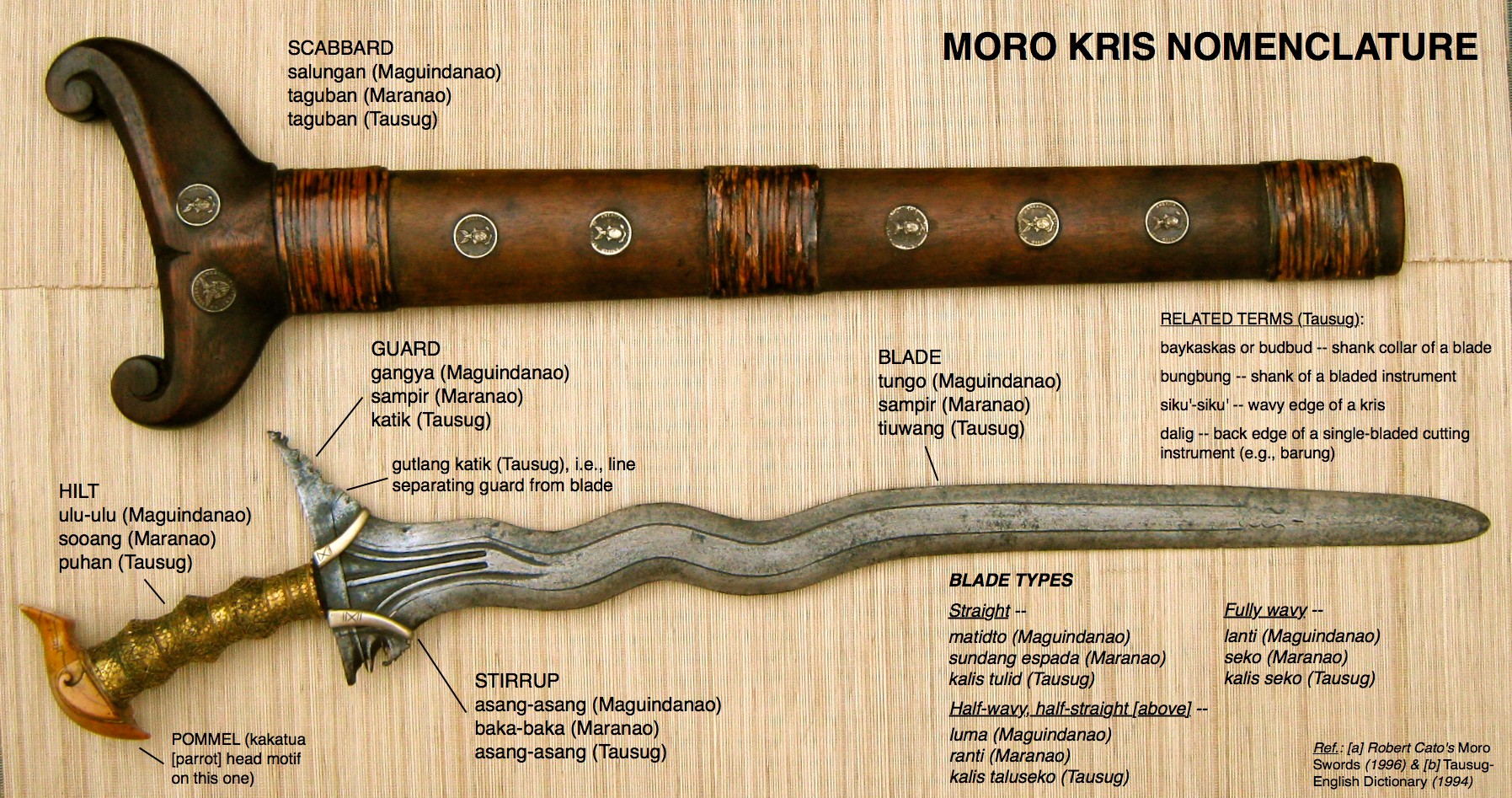 Knives Knives, at least in the field are going to typically be a utilitarian or hunting knife. These are much thicker and more durable than daggers, though in cross-section the cutting edge is more of a chisel shape, and so cuts aren't quite as keen, nor are typically knives optimized for thrusting like daggers. I've always preferred these; in fact I never go anywhere without at least a linerlock folding knife wherever I go. Even a 3 inch blade is enough to protect yourself, though it certainly helps to train. Historical examples of note include the Scamsax, which is similar to and thought to be the inspiration for the more modern Bowie. Every European culture had them. And everyone owned them; from the lowliest peasant conscript to member's of the King's court. The blades could be from 6 to even 18 inches in length; again, much like the bowie.  Typical ScramsaxKukri Typical ScramsaxKukri are more geared towards a slashing/chopping action, and have seen a resurgence in recent years as a machete blade style. Their exact origin is widely argued, but to be found from eastern Europe to Nepal and southeast Asia. Their bent appearance puts more of the blade's mass towards the point of percussion; (the point of optimum damage potential on the blade) more mass equates to more inertia, and a much more powerful stroke. The blade first entered the western pop culture lexicon during the British expansion period, thanks to the popularity of the Royal Gurkha Rifles Regiment.  Typical Kukri Typical Kukri
The Bolo was a style of farming knife popular as a machete in Indonesia and southeast Asia, a more tapered variation of the Kukri. A modern equivalent was called the Smatchet: a commando blade developed by William Fairbairn as a heavy and silent way to dispatch Axis soldiers' necks through their low hanging helmets. It was shorter and more durable than typical machetes of the time.
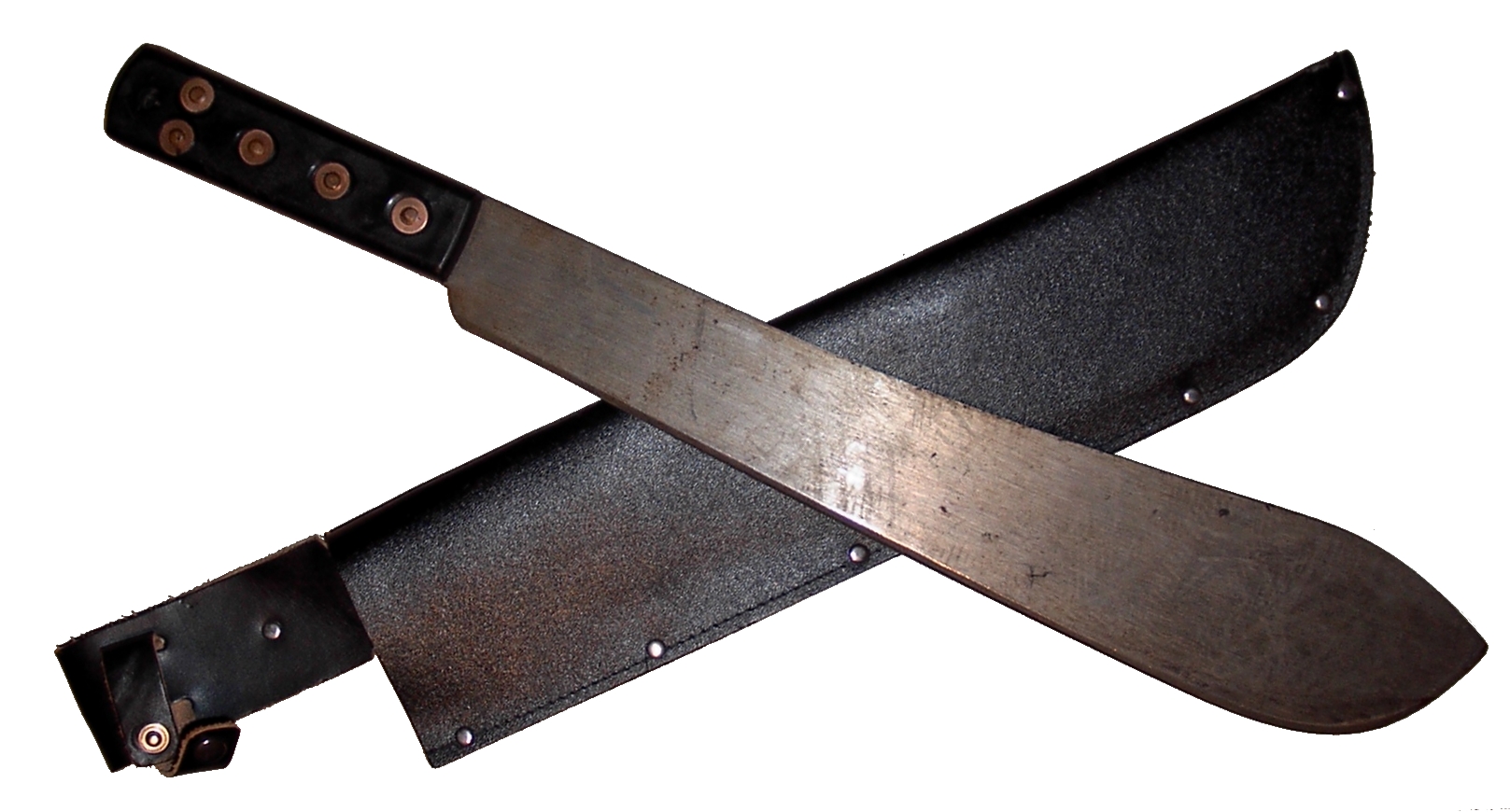
Bolo

Smatchet
Video of various Knives and Daggers and how they were used. I love the Conquest series- It really reminds me of the old SCA days:
part one
part two
part three
|
|
|
|
Post by Deleted on Dec 19, 2013 12:43:27 GMT -5
Axes are a mainstay of outdoor and camp life even today. A small pine that can be sawn down in 5 minutes can be felled in 30 seconds by axe. They were popular in combat as recently as the American Revolutionary War, and unlike most any other weapon, axes seem to operate by pure aggression. Even in the SCA, those that used these seemed on the edge of feral madness. Though probably made the most famous- or infamous by their preference by use by Norse Berzerkers, the Franks, Flemish and Saxons all had specialists that preferred axes. The troops that scared the crap out of anyone they faced were the Housecarls- Saxon shock troops as big and bad-assed as a division full of Vraes who specialized in cracking shield wall formations with their two handed Danish Axes. The Danish Axe could have a five foot long haft, and is the largest type of axe to be used in combat. The axehead itself could weigh as much as four pounds. It doesn't sound like a lot but being swung by two hands and at the end of a five foot long lever, that axe head could reach over a hundred miles an hour at a full swing. Not much can stand up to that kind of punishment. Shields split, bones break- even while wearing plate, and those wearing mail might as well be naked. This all comes at a price- energy and speed. In combat, two handed axes must be moving all the time. They're not really good for parrying, and without a shield, the user must be on the attack at ALL times- creating a strike zone around themselves with the axe in constant motion so its already at full speed when an attack is initiated. Even a remarkably fit individual cannot keep this up for long. Which means it takes a time to get up to speed. The axeblade of the axe was thinner than that of wood axes, optimized for fighting people, not logs, but in a pinch, a maul could be used. About as big and heavy, the maul is essentially a heavy rail-splitting wedge atop a long haft and used by woodsmen. 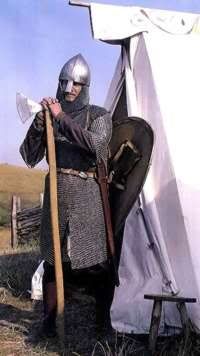 Danish Axe Labrys, or two-bladed axe, are still used today by woodsmen, and has been found in history at least as far back as the mid bronze age. It is seen as much of an emblem or symbol as an actual weapon, though the speed of attack is apparent when you can swing away back and forth as if playing tennis. 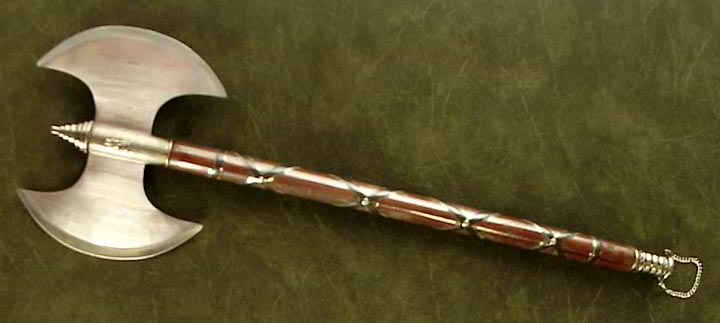 Typical 2-bladed axe The Francisca, or Frankish throwing axe, was a relatively short ranged (about 40 ft) throwing weapon that could also be used in general melee. It could cause some devastating injuries against the un or under-armored; though its use seems to be more of a distraction before a charge at the last moment. Even if the axe misses with the blade- the edge of the haft will definitely ring someone's bell; and the tapered haft and axe blade meant that they tend to skip along the ground. Foot and lower leg injuries will put sometimes multiple people out of the fight as surely as any archer's fusillade. At close range- say 20 feet or so, users are pretty accurate; and you'll find many aficionados to this day that hone their skills with a throwing axe.  Typical Francisca Conquest Video- Part OnePart TwoPart Three |
|
|
|
Post by johndramey on Dec 19, 2013 17:34:51 GMT -5
Really amazing thread, very fun to read. Thanks for taking the time to write it all up  |
|
|
|
Post by Deleted on Dec 19, 2013 18:14:38 GMT -5
![]()  A real "blast from the past" for me too.. arr arr. Im kind of busy at work, but when I get a chance Ill stick maces, scepters, flails and hammers next. Since its a more modern weapon I'll mention the Peskett first as kind of an appetizer. The Peskett was a truly dastardly assassination device devised during WW2 by the Office of Strategic Services- the precursor to the CIA. Given to both agents and resistance fighters, the Peskett combined three fundimentally different assassination principles. It looked a bit like a steel baby rattle, but had a handle topped with a weighted end for bludgeoning. A slide button innthe grip released a concealed stiletto blade for obvious uses. And were that not enough, the pull of a ring uncoiled a length of steel garrote wire for throttling. Kind of the Swiss Army knife for 'killin' nazis'. It just occurred to me that I've never seen one with a carrying strap at the base of the handle. Striking with it effectively turns the device into a flanged mace- a type of flail that drastically multiplies the impact of a similar weighted mace head in a straight haft. Diabolical! |
|
|
|
Post by Deleted on Dec 19, 2013 23:00:04 GMT -5
Maces, Scepters, Flails, Hammers and Weird-assed weapons:The absolute basic weapon, just a lever; the mace, presumably was a natural adaptation of a simple wooden club. Wooden clubs, or the modern equivalent, baseball bats are cheap to produce, easy to find, and don't suffer from too many political furry eyebrows when owned by the lower class. Not just a bludgeoning weapon, the natural progression of the simple club was perhaps 8-10 nails hammered through it, or even coring the head and poring concrete or molten lead into it- perhaps adding 50% to kinetic energy during a strike. Wherever there is a need for improvised deadly weapons at contact distances you will find a weapon like this- be it an enraged rioter or a defensive truck driver protecting himself from loadjackers.  Makes me want to listen to the Sex Pistols. Makes me want to listen to the Sex Pistols.There are many kinds of mace, such as the Morningstar. A spiked iron ball on an iron or wood haft, Morningstars were heavy enough to pound the wearer of any kind of armor to pudding, and would add piercing damage to leather and mail wearers. They and other mace styles such as the flanged mace were specifically used as anti knight weapons, as swords, most knives, arrows, spears and bolts couldn't match its effectiveness against plate. Naturally only nobility and royalty were expected- or allowed to use it. As time went on the mace, and its ornamental equivalent, the scepter, became as much a symbol of leadership and the monarchy as the sword. Perhaps more so. 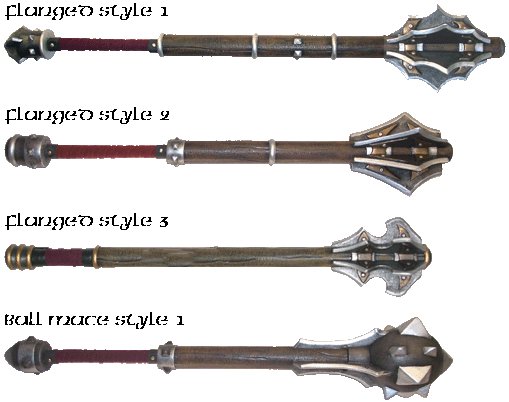 Flails Flails were essentially maces with the head set on a chain. And sometimes there were three or more heads. Not only did a decent swing double or triple the damage potential of a similarly massed mace, but its flexibility allowed the weapon to strike home around weapon and shield. In terms of a game they would negate parrying bonuses. Like the axe, flails-especially two handers, were entirely offensive weapons. And as such also need to be in motion not only to develop a strike zone where you can hit an enemy, but just to be able to control the motion of the chain. Nunchakus appear to operate on a similar school of thought- as they are also a type of flail.  War Hammers War Hammers are presumably derived from carpentry or smithing hammers put to expedient use against armored and un-armored soldiers, but was effective enough against plated knights that other knights began using specially designed versions. Sometimes topping a polearm as a polehammer or halberd, the new war hammer typically was one of 3 or sometimes 4 separate weapons set into the head. Spiked crow's beaks, blades, and hooks could also adorn warhammer heads- creating a Swiss Army Knife selection of weapons for adapting to conditions and opponents.  Bill Hooks Bill Hooks are another specialty weapon adapted from hedging and pruning bills to snag and subdue an armored knight by the flanges, buckles, or straps. They were also sharp enough to slash open warhorses or unarmored foot soldiers. The head can also be added to multiple-use heads like warhammers and halberds. 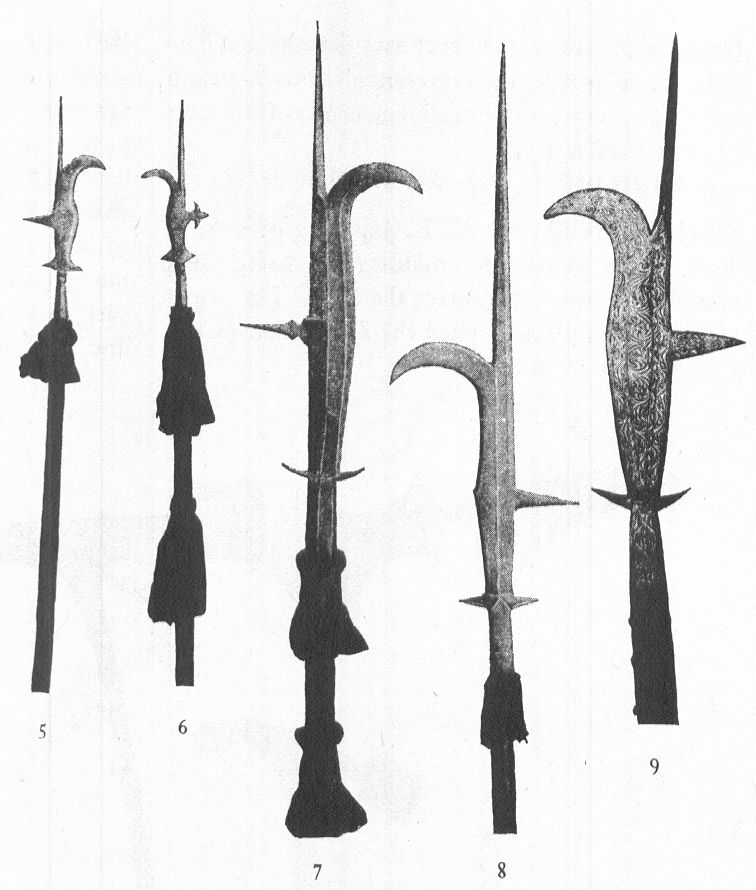 Godendags Godendags were improvised weapons made and used by well-built Flemish farmer militias. Fast and cheaply made, These were essentially a polearm version of the spiked club. They easily had a similar kinetic energy curve to mauls, danish axes, and other heavy melee weapons. In Flemish humor of the day, Godendag means "Good Day".  Bardiche Bardiche were axe-like polearms particularly used in Romania and other parts of eastern Europe. They had broad, scythe-like axe heads; perhaps a development of the Dacian Falx. (Itself similar to the Japanese Naginata or long handled sword). Another of the He-Man two-handed weapon types you would expect Vraes to use. Along with the Falx, the Bardiche could be used to try to reach around shields, and were heavy enough to split most helmets.Also like most large weapons, they required room to maneuver, and were ineffective when used in close quarters- shoulder to shoulders with mates or within dagger range with the enemy.  Falchions Falchions were an attempt to combine the versatility of a sword with the raw attack power of an axe. The overall design is still in use and available in any sporting goods or hardware store as the machete. Some Falchions looked like oversized meat cleavers, others like reversed-edge scimitars. Falchions were better against light armor like mail than most sword-type weapons.  The Awl Pike, of Ahlspiess, was a German heavy anti-armor spear with a very long and reinforced bodkin-style spear tip and couched with rondell guard to protect the hands and lock it under the arm. Essentially the footman's version of the knight's lance.  Some of these I grouped here just so it would flow better with the Conquest video: part onepart twopart three
|
|
|
|
Post by Deleted on Dec 21, 2013 15:52:41 GMT -5
SwordsThis is gonna be a good one, so bear with me. I've owned an played with a few. And for me I always preferred the single edged, curved short swords like the Scimitar and the Wakizashi. Short Swords and Gladius: This ambiguous class of weapons were usually intended for use in close quarters as a primary weapon, or sometimes as a lightweight backup while on campaign. They could also have a sense of utility. The Wakizashi in particular was considered an auxiliary to the Tachi; Part hunting knife, part close quarters defender, part parrying dagger. All could be used for slashing and piercing, though the Gladius was primarily designed for the penetrating blow, and curved weapons always favor the slash. Short swords outlasted their longer counterparts in military and personal combat well into the 20th century as the heavy bayonet. ![]()  Gladius Hispaniensis Gladius Hispaniensis Wakizashi Wakizashi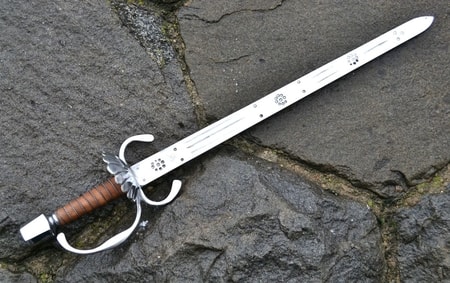 Dussack; a precursor to the cutlass Dussack; a precursor to the cutlass Norse Seax-style shortswords Norse Seax-style shortswords Basket-Hilted Shortsword popular as a defensive sidearm until the advent of the cutlassBroadswords Basket-Hilted Shortsword popular as a defensive sidearm until the advent of the cutlassBroadswords; Spatha: These were longer; blade-heavy weapons that were used both in gladiatorial combat and also favored by Roman Centurions, and later on by high status Norse warriors. The Spatha looked simply like a lengthened Gladius; though the length of its blade lent itself more to sweeping blows than its shorter cousin. As time went on, the successors to the Romans such as the 'barbarians' and the Byzantines, and especially the Norse, developed the design to all kinds of lengths, with quilions, crossguards, and later; baskets to protect the hand. The state of European metallurgy in 800AD was crude, and high quality steel swords were pattern-welded and extremely well-guarded family treasures never seen in mass use until metal smithing technology advanced enough to handle it. The legendary swords of Antiquity; Excalibur, Hrunting, Hrethel, Nagelring, were so prized because even in real life that class of weapon were one-of-a-kind, expensively made heirlooms passed down the lines of the noblest families. The use of pattern-welding was also seen in Japan, whose swordmakers used a similar technique to make up for the low quality of Japanese iron ores.  Spatha Spatha BroadswordHand-and-a-Half Bastards BroadswordHand-and-a-Half Bastards; Claymores; Tachi: The definitive weapons of both the European knight and the Japanese Samurai even though they functioned under different principles. The 'Bastard' could be a bit longer than the Viking broadswords of centuries past. Yet were easier to handle because smiths were better able to optimize the point of balance. This meant the weapon maneuvered in the hand easier, and made for faster attacks than broadswords or other heavy blade types. Despite this, the grip and the handle were long enough to allow a second hand to use it for more accuracy and much more power. The ability for single or double-handed use increased the blade's versatility. 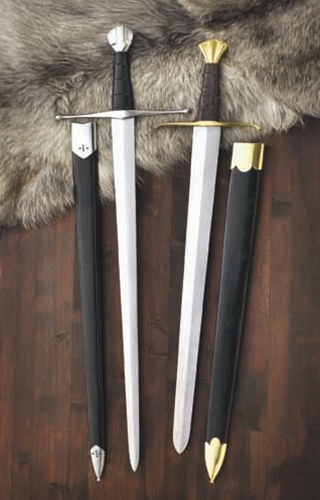 Bastard swords Bastard swordsClaymores were a Northern European heavy double-handed greatsword. It could be up to seven feet or more in length; long enough to have a secondary anti-cavalry role. In fact some claymore had secondary hilts forward of the crossguards to allow a steadier grip in thrusts and other piercing attacks.   Claymore ClaymoreTachi, and the later Katana were styles of long sword that favored the slicing cut; thought thrusts could be made. There were other differences in operation. European swords tended not to be terribly sharp; the cutting power came primarily from the weight of the weapon and the warmasters of the age took full advantage. The knight gripped the blade as often as the grip; especially against plate-wearing knights where the pommel proved much more effective than the blade. You couldn't do that with the Japanese blades. They were specifically designed for sharpness; the blade edges would chip and shatter if used against each other. Great care had to be trained into the user to make sure parrying was done with the spine and 'skin' sides of the blade; which were made of far softer steel. Tachi-style blades took years to master, and like other heirloom swords were passed down family lines. The blades were shortened during the Meiji dynasty into something more closely fitting the Wakizashi and the single-handed sabers in use by the European cavalry soldiers of the 19th century (some were also retrofitted with looped cavalry sword hilts). They were used as late as world war two by officers.  Field-length Tachi Field-length Tachi Katana Katana
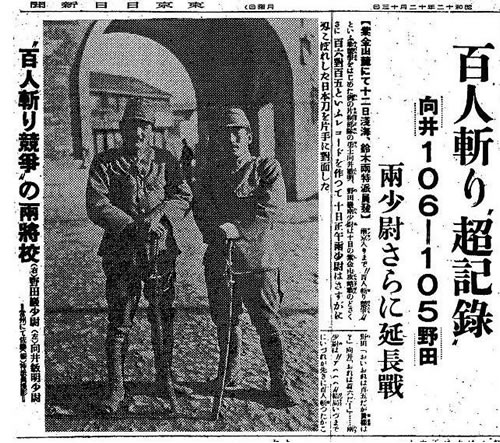 1930s era Imperial Japanese officers with swords whose blades might have been 4-500 years oldEstoc 1930s era Imperial Japanese officers with swords whose blades might have been 4-500 years oldEstoc; Rapiers: Originally an anti-armor version of the standard longsword, the Estoc had a drastically tapered and tempered tip designed to pierce mail and find the gaps in plate. cutting edges weren't emphasized, and eventually no cutting edge was present at all. The grip was of a dual-use hand-and-a-half type. 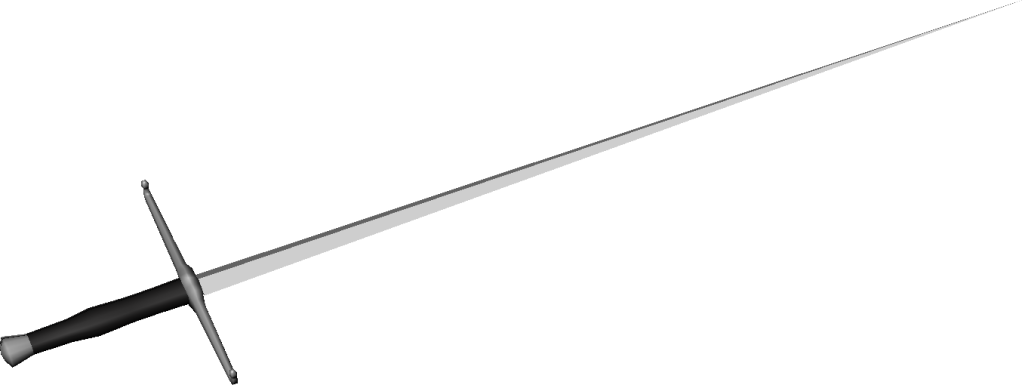 Early German Estoc Early German Estoc Tuck style Estoc with squared cross-sectionRapiers Tuck style Estoc with squared cross-sectionRapiers retained an edged blade, but were optimized for thrusting. They were light, extremely well balanced and very fast- said to be as good with the thrust as the Katana is with the slash. They were typically single-handed dueling swords, often sporting finger bows, tapered quilions, and basketed hilts to protect the hand and trap enemy blades. Typically they were used in conjunction with a main gauche or parrying dagger, a buckler, or even a cloak; used to veil attacks and foul an enemy's weapon. The modern fencing equivalent is the Epee, the skinny, "car antenna" tipped with an electrical sensor that tracks 'touches' or contact with the opponent- signifying a point against.  various rapier styles various rapier styles modern dueling armsFalcata modern dueling armsFalcata and Scimitar: The falcata is the modern name for a class of sickle-shaped short swords that were use in the early Iron Age. It had a heavy blade that put most of the mass against the point of percussion; making it excellent for chopping through wooden shields and spear hafts. The blade style was used by Greek Hoplites and later by Roman Gladiators; especially Thracians (such as Spartacus). I love these kinds of blades. They inflict a lot of pain on an opponent. Stop it with a shield and the arm can go numb with the blunt force trauma inflicted through it. They can also crush a skull through some helmets, and give a massive headache to the wearers of others. ![]()  falcata falcataThe Scimitar, Arab or Khurasan sword is a curved blade like the later saber, and is used in in the same way as a cavalry sword. 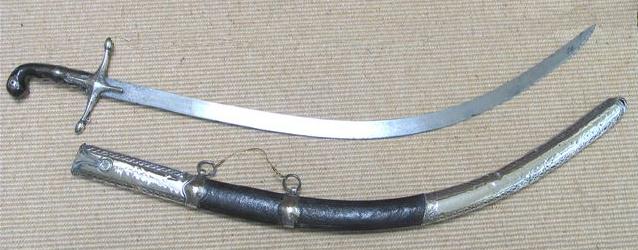 Scimitar from the time of Salah al-Din Scimitar from the time of Salah al-Din Eastern Indian style scimitarKopesh Eastern Indian style scimitarKopesh; Shotel: The Kopesh is another type of strongly curved sickle sword popular in Ancient Egypt; possibly derived from the farming sickle. The Shotel is a more extreme sickle sword from neighboring Ethiopia. I've never seen one of these up close but its thought the extreme curves were used to bypass shields to attack the flank of the opponent.  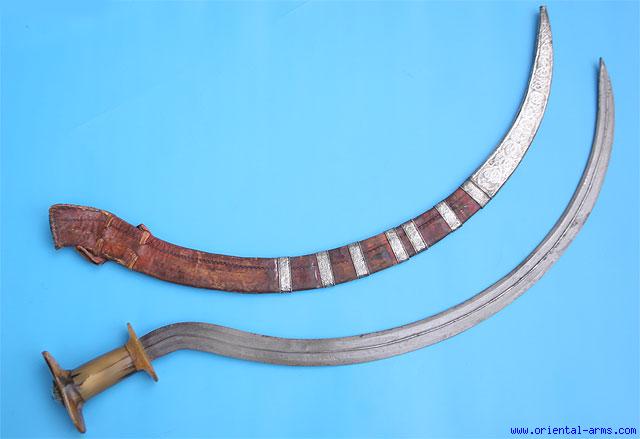 ShotelVIDEOS ShotelVIDEOS
Conquest: Broadswords
Conquest: Roman Weapons
Weapons that made Britain: Swords
Secrets of the Samurai Sword
Short clip on the Kopesh
Complete History of Swords (hour and a half)
|
|
|
|
Post by beuns on Dec 22, 2013 4:27:47 GMT -5
dayan : you're quite a scholar ! I really love this thread. I knew a lot of those but seeing some is awesome ! Great 
|
|




















































